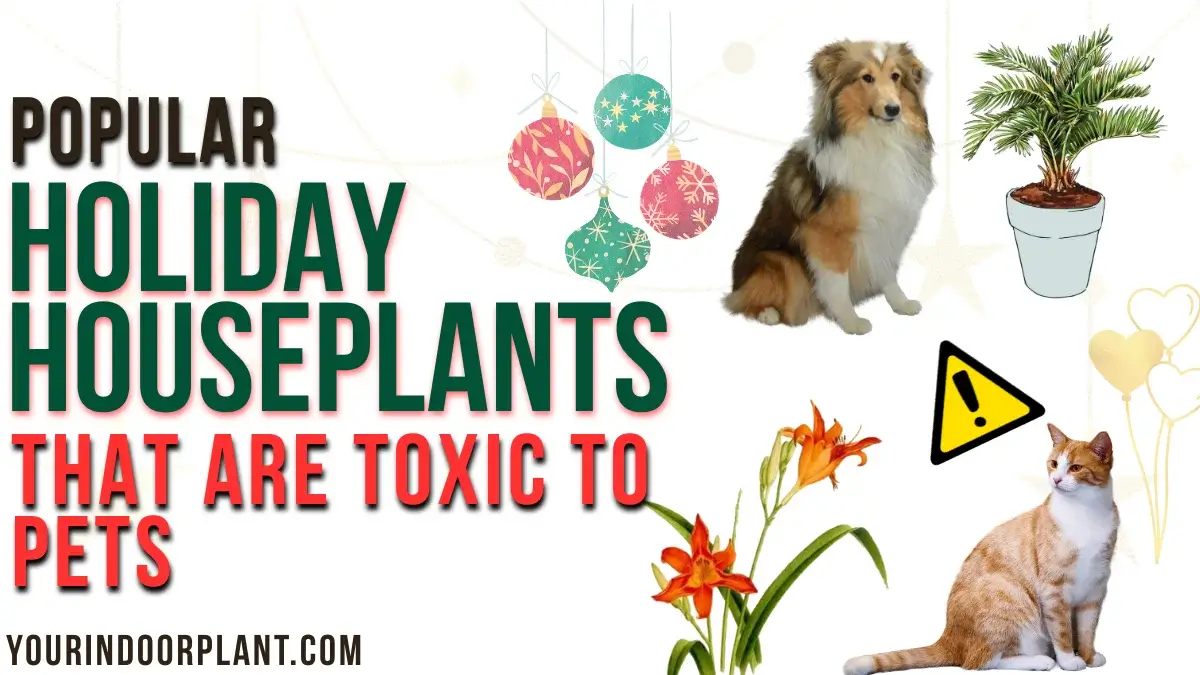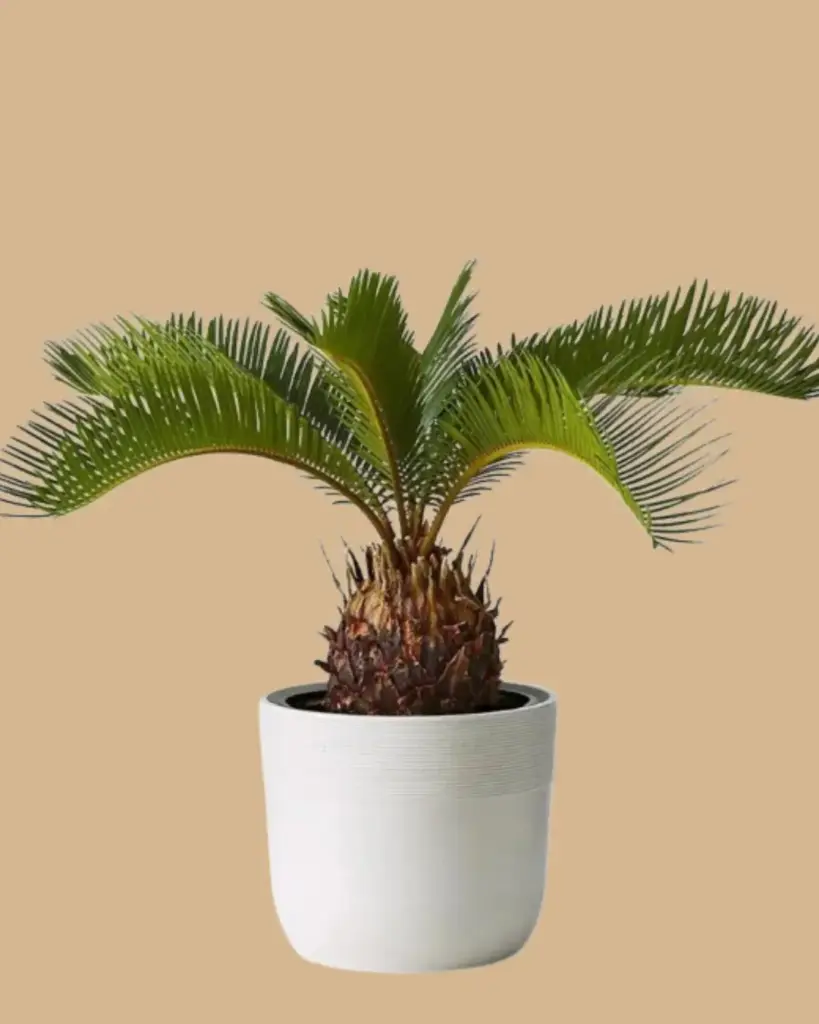17 Holiday Houseplants That are Toxic to Pets (and Safe Alternatives)

Last December, I rushed my cat to the emergency vet after she nibbled on what I thought was a harmless holiday plant. That terrifying night taught me a lesson I’ll never forget: some of the most festive plants we bring into our homes can be deadly to pets.
The most dangerous holiday houseplants for pets are:
- Sago Palm
- Lilies (true lilies and daylilies, cats only)
- Mistletoe
- Amaryllis
- Holly.
These can cause severe poisoning—and in some cases, even death—especially in cats.
The good news is, not every plant is risky, and there are plenty of safe, beautiful alternatives. In this guide, we’ll look at which holiday plants are toxic, what symptoms to watch for, how to protect your pets, and which pet-friendly plants you can decorate with instead.
Why Some Holiday Houseplants Are Toxic to Pets
Many indoor plants contain natural compounds that make them beautiful to us but harmful to pets. I used to think ‘a little nibble won’t hurt’—until I learned how these compounds work. The main culprits include:
- Saponins (found in poinsettias) irritate the digestive system
- Calcium oxalate crystals (present in amaryllis and holly) cause intense mouth pain and swelling
- Alkaloids (common in mistletoe) may affect the heart and nervous system
- Cardiac glucosides (in certain lilies) can cause fatal kidney failure in cats
Your pet can be exposed by chewing leaves or flowers, digging in potting soil, or drinking from vases where compounds have leached into the water. I’ve even seen cases where brushing against certain plants caused mild skin irritation.
Common Symptoms of Plant Poisoning
Watch for these warning signs:
- Vomiting and diarrhea
- Excessive drooling or foaming at the mouth
- Lethargy and weakness
- Tremors or seizures in severe cases
If you notice any of these symptoms, contact your veterinarian immediately. You can also check the ASPCA‘s Toxic Plant List or call the Pet Poison Helpline at 888-426-4435 for immediate guidance.
Most Dangerous Holiday Houseplants for Pets
1. Sago Palm (Cycas revoluta)
The deadliest plant on this list. While not traditionally a “holiday” plant, sago palms are increasingly sold as decorative indoor plants during winter and given as gifts.
All parts are poisonous, but the seeds are most toxic. According to PetMed, the survival rate is approximately 50%, even with aggressive treatment.
The plant causes severe liver failure that can appear within 2-3 days, with additional symptoms including:

- Distended abdomen
- Abdominal pain
- Increased drinking and urinating
- Yellow discoloration to eyes, gums, skin (jaundice)
- Black-tarry stool (melena)
- Bruising
- Bleeding from nose or mouth
- Bloody urine.
I’ve spoken with three different pet owners who lost their dogs to Sago Palm poisoning. Each one told me the same thing: ‘I had no idea it was dangerous.’ Don’t let this be your story.
My advice: If you have any sago palms in or around your home, remove them immediately if you have pets. This is non-negotiable—the mortality rate is simply too high.
I learned the hard way to do a ‘plant audit’ before every holiday season. Now, I walk through my home with my phone open to the ASPCA app, checking every single plant before December arrives.
2. True Lilies (Lilium spp.) and Daylilies (Hemerocallis spp.) — CATS ONLY
The most dangerous plant for cats during the holidays. Even tiny amounts—a nibble of leaf, a few grains of pollen—can cause fatal kidney failure in cats within 72 hours.
⚠️ CRITICAL FOR CAT OWNERS: MSPCA Angell notes that treatment is most effective if started within 6 hours of ingestion. Delaying treatment beyond 18 hours can be fatal. All parts of true lilies and daylilies are toxic, and exposure to pollen alone has caused acute kidney injury.
⚠️ Lily poisoning in cats is a true emergency—don’t wait!
Common holiday varieties include Easter lilies, Stargazer lilies, Asiatic lilies, and Tiger lilies. These should never be in a home with cats. If you suspect exposure, seek veterinary care immediately—this is a true emergency.
Note: Peace lilies and Calla lilies (discussed below) are different species and cause irritation but not kidney failure.
3. Mistletoe (Viscum album / Phoradendron)
Both European and American varieties are highly dangerous. Toxins can cause vomiting, diarrhea, low heart rate, difficulty breathing, and collapse. This is one of the most serious house plant toxic for both cats and dogs. I avoid real mistletoe altogether and use artificial sprigs—no risk, still festive.
4. Amaryllis (Hippeastrum spp.)
Sold as festive “easy bloom kits,” these bulbs contains lycorine and other phenanthridine alkaloids that are highly toxic to both cats and dogs. Ingestion causes vomiting, tremors, abdominal pain, and dangerous blood pressure changes. The bulbs are especially dangerous. Keep them completely out of reach—or better yet, out of the house entirely.
5. Holly (Ilex spp.)
Holly branches and berries are Christmas classics but contain theobromine (the same toxin found in chocolate) and saponins. The berries are especially problematic, causing vomiting, diarrhea, drooling, and abdominal pain in both cats and dogs.
Moderately Toxic Holiday Houseplants for Cats and Dogs
6. Cyclamen (Cyclamen persicum)
This flowering plant is popular for its bright blooms. The tubers contain terpenoid saponins that can trigger severe vomiting, seizures, and irregular heart rhythms if large amounts are eaten. This one ranks high on the “avoid completely” list.
7. English Ivy (Hedera helix)
Ivy looks stunning draped across mantels and stair rails. Ingesting leaves or berries causes vomiting, diarrhea, abdominal pain, and drooling. I don’t bother with real ivy anymore—faux garlands look just as festive without the risk.
8. Christmas Trees (Pine, Fir, Spruce)
The trees themselves are mildly toxic—oils in needles can irritate the mouth and stomach. But the real dangers are sharp needles that can puncture the digestive tract and tree water, which can contain bacteria, fertilizers, or preservatives. Keep water covered and vacuum fallen needles regularly.
9. Snake Plant / Mother-in-Law’s Tongue (Dracaena trifasciata)
These popular, low-maintenance plants contain saponins that are toxic to both cats and dogs. Ingestion causes nausea, vomiting, and diarrhea. While not typically fatal, they should be kept away from curious pets. Sometimes given as gifts during the holidays, many pet owners wonder are snake plants toxic to cats, and the answer is yes.
10. Philodendron (Philodendron spp.)
Philodendrons are year-round houseplants that often find their way into holiday decor. Like Peace Lilies, they contain calcium oxalate crystals that cause immediate mouth pain and swelling, but here’s what research published in the journal Toxins reveals: philodendrons can also trigger neurological symptoms in cats—twitching, convulsions, and even temporary kidney damage. Some pets have also developed allergic reactions to compounds in the leaves.
I’d classify them as a moderate-to-serious danger, definitely not something to keep around curious pets.
RELATED READING: 15+ Houseplant Mistakes to Avoid
Mildly Toxic Holiday Houseplants (Irritating but Rarely Fatal)
11. Poinsettia (Euphorbia pulcherrima)
Despite their bad reputation, poinsettias are only mildly toxic to cats and dogs. The danger is “very overrated,” according to veterinarians. The milky sap can irritate the mouth and stomach, causing drooling, vomiting, or loss of appetite, but serious poisoning is rare. While I still prefer safer alternatives, poinsettias are far less dangerous than their reputation suggests.
12. Peace Lily (Spathiphyllum spp.)
These elegant houseplants contain calcium oxalate crystals. When chewed, they cause mouth pain, drooling, and face pawing—uncomfortable but not life-threatening. My puppy once sniffed too close to one, and that was the last time I kept one in the house.
13. Anthurium / Flamingo Flower (Anthurium andraeanum)
Anthuriums add a tropical splash to holiday decor with their red, waxy flowers. They’re also toxic to cats and dogs, causing drooling, mouth irritation, and vomiting. A neighbor once kept one on her dining table until her kitten tried a bite—since then, she’s stuck to pet-safe poinsettia lookalikes made of silk.
14. Paperwhites / Narcissus (Narcissus papyraceus)
Paperwhites are sold in kits and often bloom indoors during December. The bulbs are especially toxic, leading to vomiting, drooling, tremors, and diarrhea. A friend’s dog once dug up a pot of these—thankfully, the vet acted quickly. Since then, I only enjoy them outside, far from curious paws.
15. ZZ Plant (Zamioculcas zamiifolia)
These trendy, low-light houseplants contain calcium oxalate crystals. While not fatal, ingestion causes vomiting, diarrhea, and mouth irritation. Sometimes given as gifts during the holidays for their easy-care nature.
16. Jade Plant / Money Plant (Crassula ovata)
Sometimes given as “good luck” gifts around the holidays, jade plants cause vomiting, lethargy, and incoordination in both cats and dogs. The toxicity is considered mild and self-limiting, but it’s still best to keep them out of reach.
17. Aloe Vera (Aloe barbadensis miller)
Often thought of as a healing plant for humans, aloe contains saponins and anthraquinone phytotoxins that cause vomiting, diarrhea, and lethargy in animals. During the holidays, it sometimes shows up in mixed planters or as a gift, so always double-check labels before bringing greenery inside.
Beautiful and Safe Alternatives
You don’t have to sacrifice festive greenery. Here are gorgeous options that won’t harm your furry friends:
- Christmas Cactus (Schlumbergera spp.): Blooms with vibrant pink or red flowers right in the middle of winter. Completely non-toxic and makes a stunning centerpiece.
- Spider Plant (Chlorophytum comosum): Resilient, easy to grow, and perfectly safe. Their trailing green-and-white leaves look great in hanging baskets and blend seamlessly into any decor.
- Orchids (Phalaenopsis spp.): For a touch of elegance, these are an excellent choice. Their long-lasting blooms come in festive shades like white, red, and purple—and they’re safe for pets.
- African Violets (Saintpaulia spp.): These compact flowering plants bring deep purple or blue hues to winter windowsills. They’re non-toxic and thrive indoors with minimal fuss.
- Fresh Herbs: Parsley, basil, and thyme not only brighten up the kitchen but are also safe around animals. A small herb pot can double as a fragrant centerpiece for your table.
- Bromeliads: These tropical plants add vibrant color and interesting texture. They’re completely safe and require little maintenance.
- Prayer Plant (Maranta leuconeura): With beautiful patterned leaves, prayer plants are non-toxic and safe for both cats and dogs. They’re an excellent choice if you want decorative foliage without worry.
- Boston Fern (Nephrolepis exaltata): These lush, feathery ferns add a classic touch of greenery and are confirmed to be safe for pets. They thrive in indirect light and can grow quite large, making them perfect for hanging baskets or decorative stands.
- Parlor Palm (Chamaedorea elegans): Also known as the Bamboo Palm, this elegant palm is non-toxic to pets and adds a tropical feel to any room. It’s shade-tolerant and easy to care for, making it an ideal choice for pet-friendly holiday decor.
While many peperomia and hoya varieties are safe and beautiful options for pet-friendly homes, some can raise questions. Learn more in our detailed guides: Are Hoya Plants Toxic to Cats and Cupid Peperomia toxic to cats.
What to Do If Your Pet Eats a Toxic Plant
Accidents happen—even the most careful owners can’t watch every curious paw. If your animal nibbles something questionable, quick action matters more than panic.
- Remove access immediately. Take away any plant material and clean up fallen leaves or berries.
- Check for symptoms. Look for drooling, vomiting, or lethargy. Keep track of what and how much was eaten.
- Call your veterinarian or the ASPCA Animal Poison Control Center at 888-426-4435. This line is available 24/7.
- If you suspect sago palm or lily poisoning in a cat, this is a critical emergency. Time is everything—seek veterinary care immediately.
- Do not induce vomiting unless a vet or poison control professional specifically instructs you to. Some substances cause more damage coming back up.
- Follow professional instructions closely. Bring the plant (or a photo of it) to the clinic if you’re told to come in.
I keep the ASPCA number posted on my fridge year-round. Knowing exactly what to do can save precious minutes in an emergency.
How to Prevent Holiday Houseplant Poisoning in Pets
The best cure is prevention. With a little planning, you can enjoy festive greenery without worry:
- Keep decorations out of reach. Place them on high shelves, mantels, or hanging baskets where curious animals can’t easily access them.
- Never bring true lilies into a home with cats. This single rule could save your cat’s life.
- Use deterrents and training. Citrus-based sprays and consistent training can discourage nibbling. I’ve found these especially effective.
- Choose artificial or non-toxic alternatives. Real mistletoe and holly might look traditional, but high-quality faux versions deliver the same festive look without the risk.
- Cover tree water reservoirs. Use a tree skirt or barrier to prevent drinking contaminated water.
- Educate friends and family. Well-meaning guests sometimes bring problematic gifts. Let them know you’re sticking with safer options.
FAQs
-
Will cats eat poisonous plants?
Yes, unfortunately. Cats are naturally curious and may chew on plants out of boredom, instinct, or because they’re attracted to the movement of dangling leaves.
-
Are poinsettias really that dangerous?
No—their toxicity has been significantly overestimated. They’re mildly irritating but rarely cause serious problems.
-
Why are lilies so dangerous to cats but not dogs?
Cats have a unique metabolic sensitivity to compounds in true lilies and daylilies that causes rapid kidney failure. Dogs may experience mild stomach upset but not kidney damage.
-
Which Christmas tree is safest?
All common varieties (fir, spruce, pine) are similarly low in toxicity. The bigger concerns are needle punctures and contaminated tree water. Artificial trees eliminate these risks.
-
Are artificial plants completely safe?
They’re non-toxic, but chewing plastic leaves or wires can still cause blockages or injuries.
Final Thoughts: Keeping Pets Safe and Holidays Joyful
A little awareness goes a long way. By knowing which plants to avoid—especially sago palm and true lilies for cats—choosing safe alternatives, and having an emergency plan, you can enjoy the season without worry. Keeping everyone safe doesn’t mean giving up festive decor—it just means decorating smart.
Before you finish reading this, do three things:
- Check your home right now for any plants on this list,
- Save the ASPCA Poison Control number (888-426-4435) in your phone as ‘Pet Emergency,’ and
- Share this guide with every pet owner you know. You might just save a life this holiday season—possibly your own pet’s.
